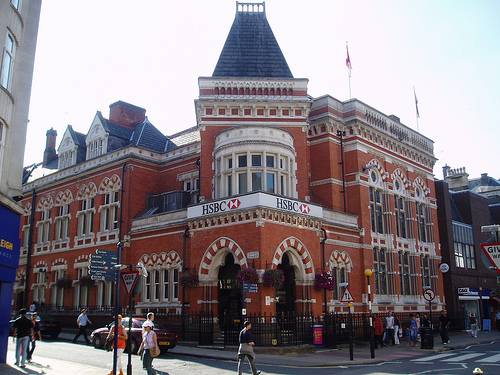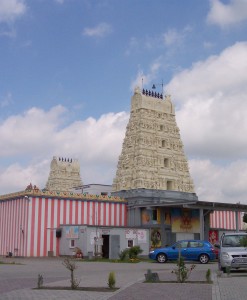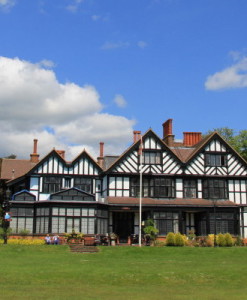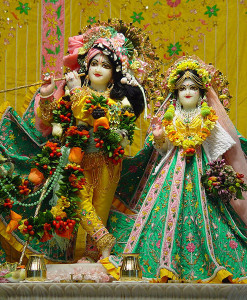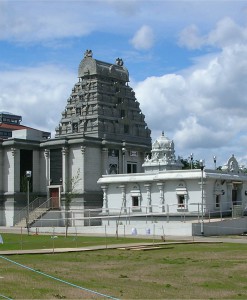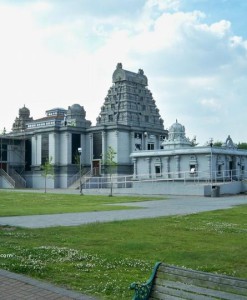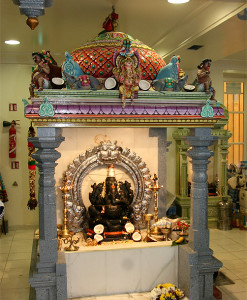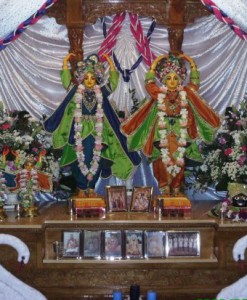No products in the cart.
The International Society for Krishna Consciousness (ISKCON) is a branch of the monotheistic Gaudiya Vaishnava tradition dating back 5000 years to Lord Krishna Himself. ISKCON was established in the West in 1966 by His Divine Grace A.C. Bhaktivedanta Swami Prabhupada (Srila Prabhupada) and has since developed into a worldwide confederation of over 500 temples, centers, communities, schools, and restaurants with some 250,000 devotees.
The mission of this nonsectarian, monotheistic movement is to promote the well-being of society by teaching the science of Krishna consciousness according to Bhagavad-gita and other ancient scriptures.
ISKCON Leicester
Since the 1970’s, devotees of ISKCON have come to Leicester to teach the message of Lord Krishna. A temple was established in the early 1980’s on Belgrave Road, before moving to a terraced house in the same area. As activities grew it was time to move to a larger property, and so a temple was established on Thoresby Street, North Evington. This remained as a temple and a home for ISKCON Leicester for many years and saw a growth in the community, its celebrations, festivities and presence across the City.
On 3rd September 2010 there was a massive explosion in the temple. By the grace of Lord Krishna, no one was harmed and, miraculously, the presiding deities Sri Sri Pança Tattva together with Srila Prabhupada were untouched in the devastation.
In the following months, the community moved from venue to venue to hold our weekly Sunday programme and festivals, while during the weekday, many families opened up their homes to host reading groups and kirtan programmes. The search for a permanent based continued.
In December 2011, ISKCON Leicester acquired one of the most iconic buildings – the former HSBC Bank on Granby Street, right at the heart of the City. This will now be the home of ISKCON Leicester. One very generous family from Leicester and London gifted the building to ISKCON.
The former bank, at 31 Granby Street, Leicester has long been acknowledged as a landmark in Leicester’s Victorian architecture. The building was built, as the headquarters of the Leicestershire Banking Company, at a time when Leicester was in the throes of a conflict of styles between the classic and the gothic. The architect of the building, Joseph Goddard, also accepted commissions from the banking company for branches throughout the East Midlands, many of which are still used today.
The Leicestershire Banking Company was established in 1829 to finance the burgeoning industries of Leicester. By 1840, the bank stood at Granby Street. The Three Crowns Hotel had previously stood here for more than a century, providing rooms and refreshments for travellers on the busy route between London and Manchester.
By 1872 the expansion of the bank’s business required a similar growth in its premises. Local architects were asked to submit their designs for a new bank in an open competition.
The winner of the competition was Joseph Goddard. He had already played an important part in introducing Victorian gothic architecture to Leicester in his design of the famous clock tower. His winning design for the bank was a deliberate contrast to the classical design of the new building of the bank’s rivals, the National Provincial Bank (today’s NatWest branch). The spectacular gothic building was executed in red brick and Portland stone with an unusual corner porch and French pavilion roofs. The front to Granby Street is particularly impressive with its three tall-decorated windows. The finished building cost £7439 and opened for business in 1874.
The interior of the bank is also a masterpiece of design. The enormous hammer beams form a lantern roof giving the building a lofty and imposing atmosphere. The pillars are hand-carved with individual friezes and each corbel stone is decorated with a different coat of arms. These heraldic arms belong to those towns and cities where the Leicestershire Banking Company carried on its business. It is not certain whether or not the stained glass windows were part of the original plan as they display certain art nouveau features. The clock in the banking hall was made by Dent’s of Southwark, also responsible for Big Ben. The portraits in the banking hall depict H Simpson Gee and Samuel Bankart, past chairman of the Leicestershire Banking Company.
The bank was so pleased with Goddard’s work that it continued to press commissions, for new bank buildings, on him throughout the remainder of the century. These include the banks at Uppingham, Wellingborough and Ashby-de-la-Zouch. These branches show the evolution of Goddard’s style away from the Victorian gothic towards a more restrained domestic revival and Queen Ann Style.
The Leicestershire Banking Company amalgamated with Midland Bank in 1890 and all it’s branches, including Granby Street branch (now a grade two listed building), became part of the bank’s network.
The building has now been acquired by ISKCON with the aspiration of making it a community hub and contributing to the regeneration of the cultural quarter of the City.
Timings: 9:00AM to 8.00PM
Some of the major festivals celebrated annually include Ram Navmi, Janmashtami, Shivratri, Holi, Ganesh Chaturthi and Diwali. Marking the Hindu New Year, Diwali is one of the grandest Hindu festivals, and attracts many visitors and devotees to the mandir.
ISKCON MISSION STATEMENT
1. To systematically propagate spiritual knowledge to society at large and to educate all people in the techniques of spiritual life in order to check the imbalance of values in life and to achieve real unity and peace in the world.
2. To propagate a consciousness of Krishna (God), as it is revealed in the great scriptures of India, especially Bhagavad-gita and Srimad-Bhagavatam. We accept the principle of transmigration of the soul (reincarnation).
3. To bring the members of the Society together with each other and nearer to Krishna, the prime entity, thus developing the idea within the members, and humanity at large, that each soul is part and parcel of the quality of Godhead (Krishna).
4. To teach and encourage the sankirtana movement, congregational chanting of the holy name of God, as revealed in the teachings of Lord Sri Caitanya Mahaprabhu.
5. To erect for the members and for society at large a holy place of transcendental pastimes dedicated to the personality of Krishna.*
6. To bring the members closer together for the purpose of teaching a simpler, more natural way of life.
7. With a view towards achieving the aforementioned purposes, to publish and distribute periodicals, magazines, books and other writings that help realize these purposes.

